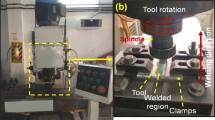The friction stir joining experiment was performed on a 6061-T6 aluminum alloy sheet 1 mm thick by optimization of different process parameters, and the microstructure and performance analysis of the joint area using a metallographic microscope, friction and wear testing machine, and scanning electron microscope were evaluated. The results show that the crystalline grains in the joint area of the specimen were refined under a given parameter, and the precipitation of the reinforcing phase improved the performance of the joint area. The best parameters for grain refinement were found to be a rotation speed of 8000 rpm and a traverse speed of 300 mm/min. The specimen obtained at 15,000 rpm and 200 mm/min exhibited the smallest milling weight loss. The smallest average friction coefficient of the specimen was observed at 8000 rpm and 300 mm/min. The friction weight loss trend of the specimens obtained under each parameter was basically the same as the friction coefficient. The wear form of each specimen was found to be mainly the adhesive wear, accompanied by the abrasive one.








Similar content being viewed by others

References
Z. J. Tan, Q. Wu, and Z. Zhang, “Numerical simulation of tool wear in friction stir welding of different aluminum alloys,” Hot Working Tech., 46, No. 7, 206–209, 213 (2017).
M. Movahedi, A. H. Kokabi, S. M. Seyed Reihani, and H. Najafi, “Effect of tool travel and rotation speeds on weld zone defects and joint strength of aluminium steel lap joints made by friction stir welding,” Sci. Technol. Weld Joi., 17, No. 2, 162–167 (2012).
X. H. Zeng, P. Xue, L. H. Wu, et al., “Microstructural evolution of aluminum alloy during friction stir welding under different tool rotation rates and cooling conditions,” J. Mater. Sci. Tech., 35, No. 6, 972–981 (2019).
P. Sahlot, A. K. Singh, V. J. Badheka, and A. Arora, “Friction stir welding of copper: numerical modeling and validation,” Trans. Indian Inst. Met., 72, No. 3, 1339–1347 (2019).
S. R. Yazdi, B. Beidokhti, and M. Haddad-Sabzevan, “Pinless tool for FSSW of AA 6061-T6 aluminum alloy,” J. Mater. Process. Technol., 267, No. 3, 44–51 (2019).
W. W. Song, X. J. Xu, S. R. Liu, et al., “Effect on the wear resistance of copper alloy surface modification layer by FSSP implanting W particles,” Mater. Trans., 60, No. 5, 765–769 (2019).
P. M. Miles, B. J. Decker, and T. W. Nelson, “Formability and strength of friction- stir-welded aluminum sheets,” Metall. Mater. Trans. A, 35, No. 11, 3461–3468 (2004).
M. Peel, A. Steuwer, M. Preuss, and P. J. Withers, “Microstructure, mechanical properties and residual stresses as a function of welding speed in aluminium AA5083 friction stir welds,” Acta Mater., 51, No. 16, 4791–4801 (2003).
X. H. Wang, K. S. Wang, X. L. Su, and K. Hu, “Preparation technique on metallographic specimen of friction stir welds of dissimilar materials,” Light Met., 34, No. 7, 45–48, 52 (2006).
K. S. Wang, X. H. Wang, X. L. Su, and K. W. Xu, “Research on friction and wear performances of joints by TIG and friction stir welding,” Rare Metal Mater. Eng., 36, No. 10, 1835–1838 (2007).
X. H. Wang, K. S. Wang, Y. Shen, and K. W. Xu, “Friction and wear property near friction stir welds,” Hot Working Tech., 35, No. 11, 4–6 (2006).
K. S. Wang, X. H. Wang, and K. W. Xu, “Research on friction and wear properties of joint by friction stir welding,” Lubr. Eng., 32, No. 2, 114–115, 158 (2007).
H. F. Wang, D. W. Zuo, D. L. Shao, et al., “Effect of process parameters on residual stress and wear and corrosion resistance of 7022 aluminium alloy by FSW,” J. Aeronaut. Mater., 31, No. 1, 41–47 (2011).
D. L. Shao, W. Z. Lu, D. W. Zuo, et al., “Finite element analysis of friction stir welding deformation of 7022 aluminum alloy,” Weld. Tech., 40, No. 1, 17–20 (2011).
Acknowledgments
This study was financially supported by the Key Research and Development Project from Anhui Province of China (Grant No. 1704a0902053), the Open Research Project of Anhui Simulation Design and Modern Manufacture Engineering Technology Research Center (Huangshan University) (Nos. SGCZXZD1801 and SGCZXZD1901), and Project of Excellent and Top-Notch Talents’ Cultivation in Colleges and Universities of Anhui Province, China (2018gxbjZD43).
Author information
Authors and Affiliations
Corresponding author
Additional information
Translated from Problemy Prochnosti, No. 4, pp. 80 – 89, July – August, 2020.
Rights and permissions
About this article
Cite this article
Wang, H.F., Zuo, D.W., Liu, S.R. et al. Wear Resistance Analysis of a Lightweight Aluminum Alloy Sheet Friction Stir Joint Area. Strength Mater 52, 565–572 (2020). https://doi.org/10.1007/s11223-020-00208-4
Received:
Published:
Issue Date:
DOI: https://doi.org/10.1007/s11223-020-00208-4



